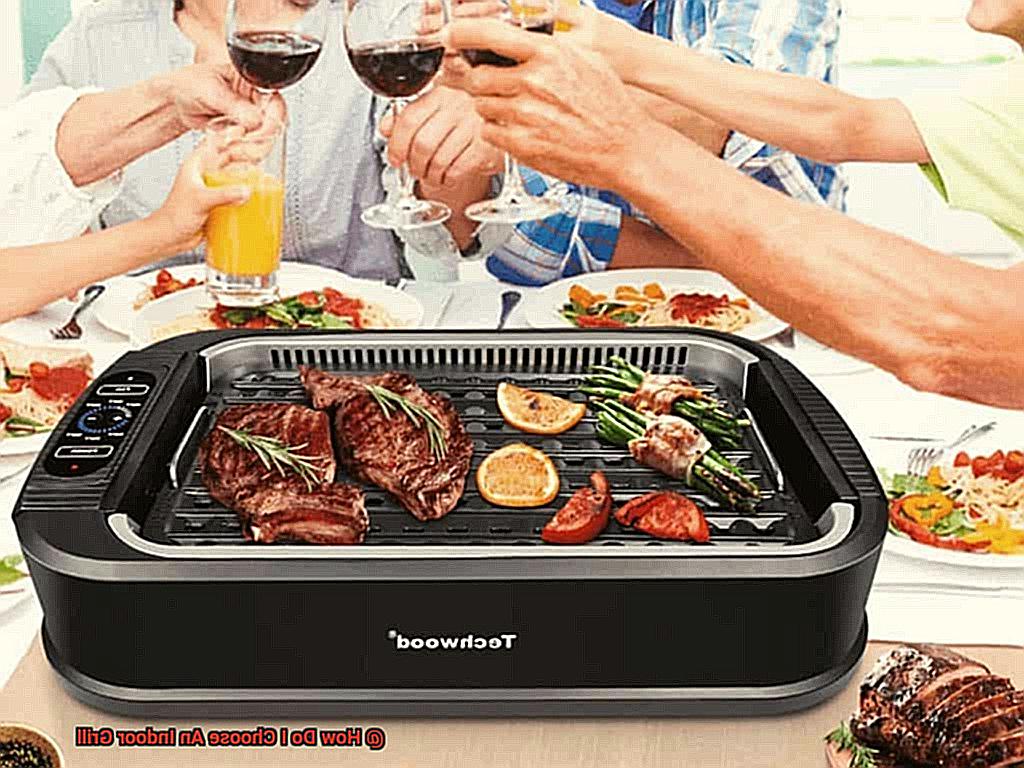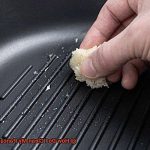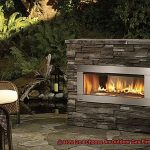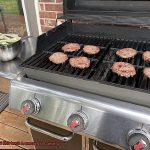Do you miss the smoky taste of grilled food during the winter months? Or are you simply looking to shake up your cooking routine with a new appliance? Whatever your reason may be, choosing an indoor grill can be overwhelming. With so many options on the market, it’s hard to know which one will suit your needs.
But don’t worry. In this blog post, we’ll help you navigate the process of selecting an indoor grill that satisfies your cravings and meets your cooking requirements. From electric and stovetop grills to open and contact grills, we’ll explore the different types of indoor grills and help you determine which one is right for you. We’ll also delve into key features such as temperature control, size, cleaning maintenance, and usability to consider before making your purchase.
Whether you’re a novice or a seasoned pro at grilling, this guide will furnish you with all the necessary information to make an informed decision when selecting an indoor grill. So put on your apron and get ready to become a grill master in the cozy confines of your own kitchen.
Contents
Types of Indoor Grills
Indoor grilling has become increasingly popular, and with so many types of indoor grills available in the market, it can be overwhelming to decide which one to choose. To help you make an informed decision, we’ve compiled the five most common types of indoor grills.
First up is the contact grill, also known as an open grill. It’s the most basic type of indoor grill and consists of two hot plates that come together to cook food from both sides simultaneously. Contact grills are perfect for making sandwiches, burgers, and grilled vegetables. They’re easy to use and clean, making them ideal for beginners or those who prefer simple grilling options.
The closed grill is another type of indoor grill that features a hinged lid covering the cooking surface. This design allows for even cooking and trapping of flavors. Closed grills are perfect for cooking thick cuts of meat, vegetables, and sandwiches. They come in different sizes, making it possible to cook for small or large groups.
If you’re a sandwich lover, then the panini press is the way to go. This type of indoor grill is specifically designed for making sandwiches. It has ridged plates that leave grill marks on the bread, giving it a crispy texture. Panini presses are easy to use and perfect for creating quick meals.
The griddle grill is yet another type of indoor grill that has a flat cooking surface, making it suitable for cooking large items such as pancakes, eggs, and bacon. They’re also great for cooking delicate foods such as fish and vegetables. Griddle grills come in different sizes and shapes to fit different cooking needs.
Lastly, smokeless grills feature advanced technology that minimizes smoke production during cooking, making them ideal for apartment dwellers or those who prefer indoor grilling without smoke. Smokeless grills come in different sizes and shapes to fit different cooking needs.
When choosing an indoor grill, consider factors such as size, cooking surface, ease of use and cleaning, and price range. Whether you prefer contact, closed, panini press, griddle, or smokeless grills, each type has unique features that can enhance your cooking experience.
Size Considerations
Size considerations should be at the top of your list. The size of your grill will dictate how much food you can cook at once and how much space it will take up on your countertop. In this article, we’ll explore some important size considerations to help you make an informed decision.
Firstly, consider the number of people you’ll be cooking for. If you’re a big family or frequently host parties, a larger grill with a larger cooking surface will be ideal. However, if you’re only cooking for yourself or a small group, a smaller grill would suffice.
Secondly, measure the available space in your kitchen before making a purchase. You don’t want to end up with a grill that takes up too much countertop space. Also, consider the height of the grill if you plan to store it in a cabinet or on a shelf when not in use.
Thirdly, think about the type and size of food you plan to cook on your indoor grill. If you plan on grilling large pieces of meat or vegetables, then a larger grill with adjustable temperature controls would be necessary to ensure even cooking. However, if you plan on grilling smaller items like burgers or hot dogs, then a smaller grill with fixed temperature controls may suffice.
Finally, keep in mind any additional features that may affect the size of the grill such as built-in fans or smokeless technology. These features may add bulk to the grill and therefore require more counter space.
Temperature Control
Temperature control is the key to achieving perfectly cooked meals every time, and it should be at the top of your checklist when shopping for a new indoor grill.
Firstly, it is important to consider the type of heating element used in the grill. Infrared heating elements are more efficient in controlling temperatures compared to heating coils. They offer faster heat-up times and consistent cooking temperatures, making them ideal for those who want a grill that heats up quickly and maintains a steady temperature.
The temperature range of the grill is another important factor to consider. If you plan on cooking a variety of foods, you need a grill with a wider temperature range. This will give you more versatility in your cooking options and allow you to experiment with different recipes. A wider temperature range allows for versatile cooking options and makes it easier for you to cook different types of food.
The thickness of the cooking plate also affects temperature control. Thicker plates hold heat better, and they are ideal for cooking thicker cuts of meat that require longer cooking times. On the other hand, thinner plates heat up quickly but may not hold heat as well, making them better suited for quick cooking tasks like grilling vegetables.
Lastly, make sure your indoor grill has a built-in thermometer. A thermometer helps you monitor the internal temperature of your food, ensuring that it is cooked safely and thoroughly. Some grills come with a built-in thermometer, while others require you to purchase one separately. A built-in thermometer is essential for safe and precise cooking results, so invest in one that has this feature.
Construction Materials
If you’re in the market for a new indoor grill, it’s important to consider the construction materials. Not only can they impact the durability, but they also affect heat distribution and even the flavor of your food. As an expert in this field, I’ve researched the different materials available and their unique properties to help you make an informed decision.
Let’s start with stainless steel. This material is sleek and durable, making it easy to clean. It also has excellent heat retention properties, ensuring your grill will stay hot and cook your food evenly. However, stainless steel can be more expensive than other options and may not distribute heat as evenly.
Next up is cast iron. This material is known for its ability to distribute heat evenly and retain heat for extended periods of time. It’s also durable and can add flavor to your food as it cooks. However, cast iron can be heavy and difficult to clean.
Ceramic is another popular material used in indoor grill construction. Ceramic grills are great at cooking at high temperatures and retaining heat for long periods of time. They’re also more affordable than stainless steel or cast iron options. However, ceramic grills may require more maintenance than other materials and can crack if not handled carefully.
Finally, some indoor grills may use a combination of materials in their construction. For example, a grill may have a stainless steel exterior with a cast iron or ceramic cooking surface. This hybrid approach offers the benefits of multiple materials in one appliance.
When choosing an indoor grill based on construction materials, consider your own needs and preferences. Do you prioritize durability and ease of cleaning? Or are you more concerned with even heat distribution and flavor? Understanding the unique properties of each material will help you choose the best indoor grill for you.
Factors to Consider When Choosing an Indoor Grill
An indoor grill may be just what you need. But with so many options on the market, how do you choose the right indoor grill for your needs? Let’s dive into the factors to consider when selecting an indoor grill.
First and foremost, consider the type of indoor grill. There are three main types: contact grills, open grills, and electric grills. Contact grills are perfect for cooking quick meals between two heated plates, while open grills mimic outdoor grilling with a heated surface and open flame. Electric grills offer precise temperature control without any direct contact with flames or hot surfaces. Each type has its own unique advantages and disadvantages, so it’s important to choose the one that suits your cooking style and needs best.
Next, size matters. Do you have limited counter space in your kitchen? How many people will you be cooking for? These are important questions to consider when selecting the size of your indoor grill. You don’t want a massive grill taking up precious kitchen real estate if you’re only cooking for one or two people.
Another crucial factor is the cooking surface. Look for a non-stick surface that’s easy to clean – you’ll thank yourself later. And if you plan on cooking a variety of dishes that require different temperatures, opt for an indoor grill with adjustable temperature controls. This will give you greater control over the cooking process and ensure perfectly cooked meals every time.
Material also plays a role in choosing an indoor grill. Stainless steel is sleek and durable, while cast iron holds heat well and imparts a delicious smoky flavor to food. Aluminum is lightweight and affordable but may not be as durable as other materials. Consider which material suits your cooking needs and budget best.
Last but not least, price is an important consideration. Indoor grills can range from budget-friendly options under $50 to high-end models that cost over $500. Consider how often you’ll be using the grill and what features are most important to you when selecting a model that fits your budget.
Open Grills
Look no further. Open grills are one of the most popular types of indoor grills, featuring an open grilling surface that gives your food that delicious charred and smoky flavor. But how do you choose the right open grill for your needs?
First, size matters. Consider how much food you’ll be cooking and choose a grill size accordingly. A larger grill is perfect for cooking for a crowd, while a smaller grill is ideal for intimate meals.
The material of your grill also plays a significant role in your grilling experience. Cast iron is excellent for heat retention and even cooking, while stainless steel is durable and easy to clean. Aluminum heats up quickly and is lightweight, but may not be as durable as cast iron or stainless steel.
When it comes to heating elements, you have two options: gas or electric. Gas grills heat up faster and offer more heat control, while electric grills are generally easier to clean.
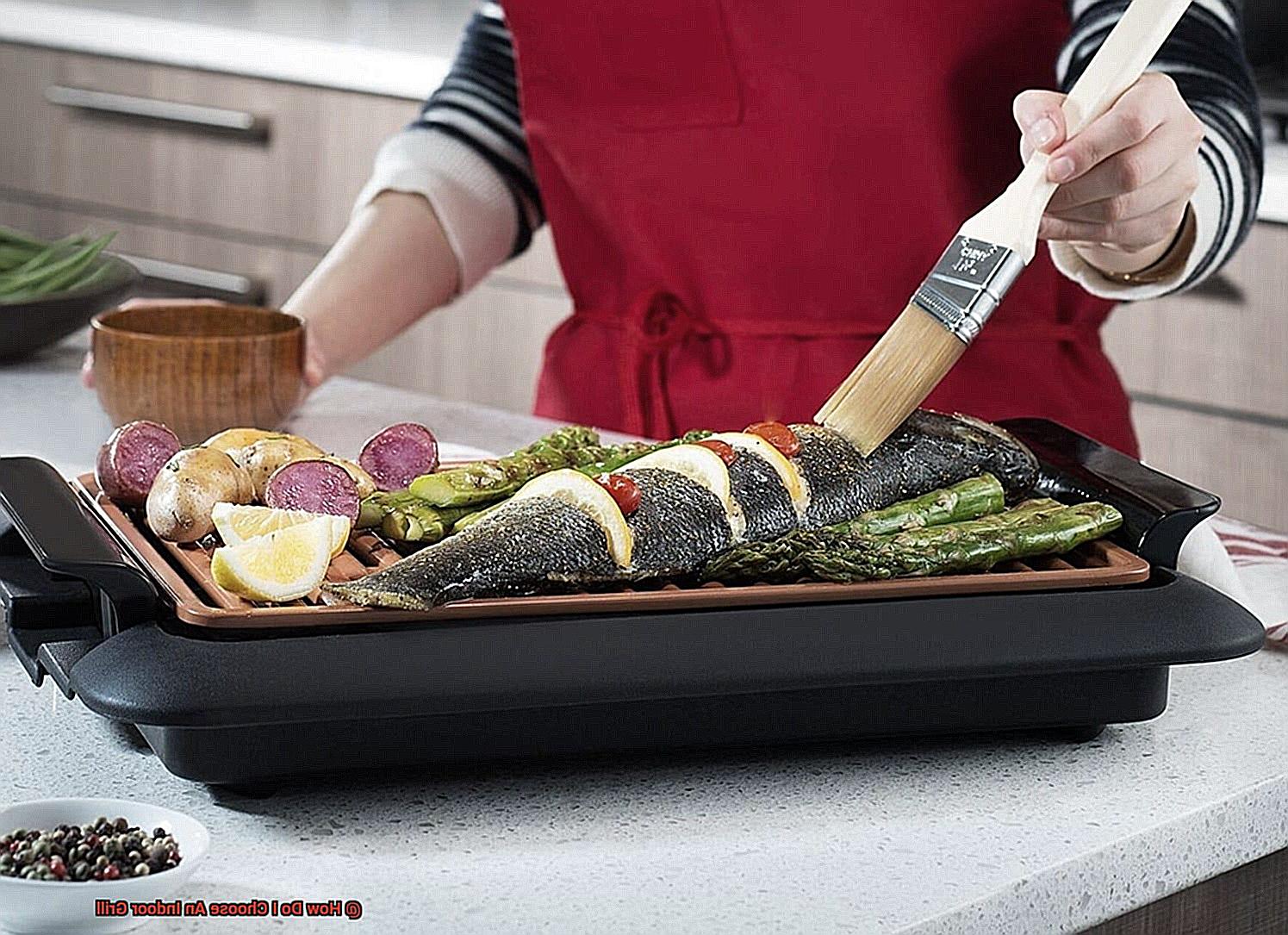
Last but not least, consider any additional features that may make your grilling experience even better. Temperature control settings allow you to adjust the heat according to what you’re cooking, while removable plates make cleaning a breeze. Some grills even have adjustable height settings for different types of food.
Contact Grills
If so, then a contact grill, also known as a panini press, is an essential appliance for your kitchen. With two heated plates that can be opened and closed, contact grills allow for quick and easy indoor grilling. But with so many options available in the market, how do you choose the perfect contact grill for your needs? Don’t worry – we’ve got you covered with our expert knowledge on the topic.
Let’s start with plate size. It is a crucial factor to consider as it determines how much food you can cook at once. If you’re cooking for a family or a group of friends, larger plates are a must-have. However, if you’re single or cooking for two, smaller plates may be more suitable. Additionally, thicker plates provide better heating and searing capabilities, leaving you with that perfect crispy texture.
The type of material the plates are made from is another crucial factor to consider. Non-stick coatings are common and make for easy cleanup, but some people prefer ceramic plates as they are more durable and scratch-resistant. It’s also important to consider how easy it is to remove the plates for cleaning. Trust us; you don’t want to be stuck scrubbing away at stubborn grill plates for hours on end.
Finally, temperature control options are crucial when it comes to getting that perfect cook on your food. Some models may only have one temperature setting, which could limit your cooking abilities. Adjustable temperature controls offer more precise cooking options and allow you to cook a range of foods at different temperatures.
Hybrid Grills
Look no further than a hybrid grill. These versatile grills allow you to switch between electric and gas grilling modes with ease, providing both convenience and flavor.
One of the biggest advantages of a hybrid grill is versatility. Whether you want to grill up a quick meal or slow-cook something for hours, a hybrid grill has you covered. Plus, many hybrid grills come with additional features like side burners or rotisserie attachments, making them even more versatile.
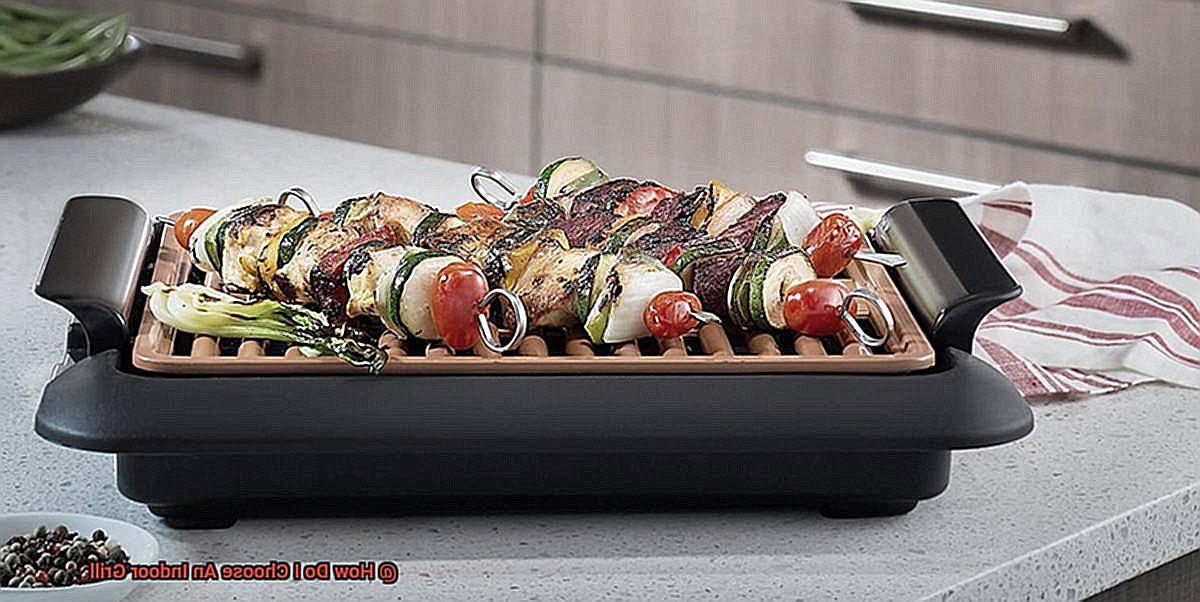
When choosing a hybrid grill, there are several key factors to consider. Size is important – make sure the grill is large enough to accommodate your cooking needs. You’ll also want to consider the number of burners and whether or not you need a side burner for added convenience.
The cooking surface is another important consideration. Look for materials like cast iron or stainless steel that offer even heat distribution and can withstand high temperatures. And don’t forget about fuel type – some hybrid grills use propane while others use natural gas, so make sure to choose a grill that uses a fuel source that is readily available in your area.
Price is always a consideration when purchasing a grill, but remember that hybrid grills offer more versatility and convenience than traditional electric or gas grills. With careful consideration of size, cooking surface, fuel type, and price, you can choose a hybrid grill that will provide you with years of delicious meals.
gTsOVhyTaNw” >
Conclusion
In conclusion, the overwhelming number of indoor grill options on the market can make choosing the right one seem like a daunting task. However, by taking into account your cooking needs and preferences, you can make an informed decision that will elevate your culinary skills.
From contact grills to closed grills, panini presses to griddle grills, and smokeless grills, each type offers unique features that can enhance your cooking experience. It’s important to pay attention to size considerations as well, ensuring that your chosen grill fits comfortably in your kitchen space while meeting your cooking requirements.
Temperature control is key for achieving perfectly cooked meals every time. When making a purchase, consider factors such as the type of heating element used in the grill, temperature range, thickness of the cooking plate, and built-in thermometer.
Construction materials are also crucial for durability, heat distribution, and even flavor. Stainless steel is sleek and durable while cast iron holds heat well and imparts smoky flavor to food. Ceramic is excellent at high-temperature cooking and adds an extra layer of sophistication to any dish.
Lastly, don’t forget to consider factors such as type of indoor grill (contact or open), size of plates or burners (for hybrid grills), fuel type (propane or natural gas), and price range before making a purchase.
With these factors in mind and our expert knowledge on the topic at hand, you’ll be able to select an indoor grill that satisfies your cravings and meets your cooking requirements.

